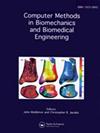A multi-objective optimization of degradable polymer vascular stents.
IF 1.7
4区 医学
Q3 COMPUTER SCIENCE, INTERDISCIPLINARY APPLICATIONS
Computer Methods in Biomechanics and Biomedical Engineering
Pub Date : 2025-07-02
DOI:10.1080/10255842.2025.2524477
引用次数: 0
Abstract
Degradable polymer stents face challenges of insufficient support and early fractures. A multi-objective structural optimization with three design variables was performed to enhance both mechanical and degradation performance, evaluated by effective working time (EWT) and support force (F). Surrogate models established the relationship between design variables and performance, while a genetic algorithm identified the optimal solution. The radial basis function (RBF) model exhibited superior accuracy. Compared to the initial structure, the optimized stent increased F by 52.1% and EWT by 27.4%, with prediction errors below 4%. This study presents an effective strategy to improve polymer stent performance.
可降解聚合物血管支架的多目标优化。
可降解聚合物支架面临支撑不足和早期骨折的挑战。采用有效工作时间(EWT)和支撑力(F)对结构进行多目标优化,以提高结构的力学性能和降解性能。代理模型建立了设计变量与性能之间的关系,而遗传算法确定了最优解。径向基函数(RBF)模型具有较好的精度。与初始结构相比,优化后的支架F提高了52.1%,EWT提高了27.4%,预测误差在4%以下。本研究提出了一种提高聚合物支架性能的有效策略。
本文章由计算机程序翻译,如有差异,请以英文原文为准。
求助全文
约1分钟内获得全文
求助全文
来源期刊
CiteScore
4.10
自引率
6.20%
发文量
179
审稿时长
4-8 weeks
期刊介绍:
The primary aims of Computer Methods in Biomechanics and Biomedical Engineering are to provide a means of communicating the advances being made in the areas of biomechanics and biomedical engineering and to stimulate interest in the continually emerging computer based technologies which are being applied in these multidisciplinary subjects. Computer Methods in Biomechanics and Biomedical Engineering will also provide a focus for the importance of integrating the disciplines of engineering with medical technology and clinical expertise. Such integration will have a major impact on health care in the future.

 求助内容:
求助内容: 应助结果提醒方式:
应助结果提醒方式:


